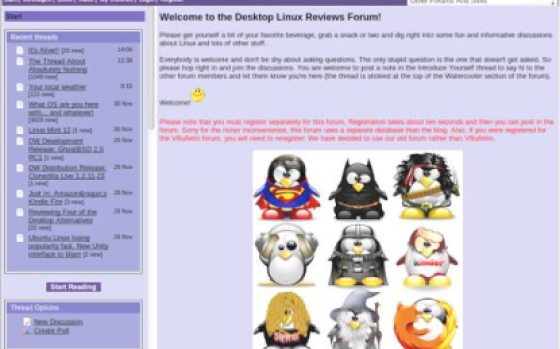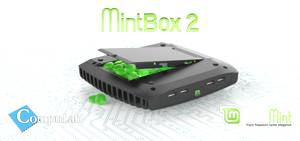Full-featured desktop Linux distributions like PCLinuxOS and Linux Mint are quite useful, but there are times when a smaller and lighter distro can also be desirable. CDlinux is petite mini-distro that can be installed on a USB device or on a Windows C: partition.
I thought it might be a nice change of pace to take a look at it and see how useful it might be for the folks that need a more portable version of Linux.
There are three versions of CDlinux that you can download. The standard version is 65MB and contains a minimal desktop environment, the community version includes more software and is 225MB, and the mini version is console only and weighs in at an extremely petite 30MB. The standard version can also be used for rescues since it contains useful admin and rescue tools. The community edition comes with more software but is overkill if you simply want a portable rescue distro.
For the purposes of this review, I downloaded the 225MB community version.
What’s New In This Release
The current release is actually a bug release so there are no new features included in it.
Here’s a list of the bugs that were fixed and the packages that were upgraded:
Bug fixes:
X won’t start on the standard edition
“X -configure” can’t generate xorg.conf.new
Alt+Shift can’t toggle between keyboard layouts
Java Plug-in for Firefox doesn’t work
Upgraded packages:
alsa-lib-1.0.23
curl-7.20.1
goffice-0.8.2
jasper-1.900.1.15.fc13
jre-6u20
lvm2-2.02.63
CDlinux also includes:
linux-2.6.33.2
xorg-server-1.8.0
mesa-7.8.1
gtk+-2.18.9
qt-4.6.2
jre-6u19
firefox-3.6.3
gparted-0.5.2
bash-4.1.5
mc-4.7.0.4
Hardware Requirements & Installation
Hardware Requirements
I was not able to locate a list of specific hardware requirements on the CDlinux site. If you have them please post them in the comments section below.
If the developers read this review, please consider adding a section to your FAQ that covers system requirements. Doing so makes it much easier for me and for other folks interested in possibly using CDlinux.
Installation Steps
Since my only USB keychain device disappeared a while back, I didn’t do an install of CDlinux. Instead I ran it as a Live CD.
Running it as a Live CD worked very well and I was pleasantly surprised at how fast it was. Loading applications was zippy and I didn’t notice any crashes.
Booting & Login
Bootsplash
When you first boot into CDlinux, you’ll be taken to a GRUB4DOS bootsplash screen.
The bootsplash screen lets you choose from the following languages:
German
English
French
Japanese
Korean
Chinese
It’s not particularly surprising that Chinese is an option, since that’s where CDlinux was created.
Login Screen
Since I ran CDlinux as a Live CD, there was no need for me to login.
The Desktop
CDLinux uses Xfce, a lightweight desktop environment. Xfce has the virtue of not requiring the system resources that are necessary to run GNOME or KDE. When you first boot into CDlinux, you’ll find the following on the desktop:
Home
Trash
Floppy Drive
Click the CDL button to access the usual application menus. Applications are listed in the following categories:
Accessories
Games
Graphics
Multimedia
Network
Office
System
The only slightly odd thing about the application categories is the choice of “Network” rather than “Internet.” I guess it doesn’t make that much of a difference but the word “Internet” seems a better and more obvious choice to me.
You can also access a terminal window, settings, file manager, logout, and About CDlinux from the CDL button.
Navigating around the CDlinux desktop is easy and you should be able to find everything you need to use or configure your system.
Bundled Software
Here’s a sample of the software included with the community version of CDlinux.
Games
DOSBox
FreeCell
msHearts
Solitaire
Spider
WinMine
Graphics
GIMP
Image Viewer
XSane-Scanning
Internet
aMule
FileZilla
Firefox
My Network Places
Pidgin IM
RDesktop GUI
Skype
Sylpheed
Transmission
Vidalia
Wicd Network Manager
Multimedia
Livestation
MPlayer Media Player
SMPlayer
Sound Volume
Xfburn
Office
AbiWord
ePDFViewer
Gnumeric
KchmViewer
Sound and Multimedia
YouTube & Flash
I loaded a Lady Gaga video on YouTube. It looked and sounded great.
CDlinux surprised me by being multimedia-friendly, for the most part. I didn’t need to configure my sound card or do anything else. Given that CDlinux is a portable mini-distro, I hadn’t expected sound and video to work so well on it by default.
Problems & Headaches
One slightly annoying thing I noticed about CDlinux is that it has a flash blocker extension installed by default in Firefox. While I’ve made it clear that I dislike flash, I think having this installed by default in Firefox is unwise. I was familiar with the flash blocker so I knew how to deal with it. I just needed to click the flash overlay to play YouTube videos and to display any other flash-based objects.
But people who don’t know about it might be confused why flash-based multimedia won’t load properly in their browser. I think it would be a good idea for the flash blocker to be disabled by default by the CDlinux developers. That would prevent any confusion on the part of new users and might save them a lot of aggravation.
It’s also somewhat disappointing that CDlinux can only be installed on a USB device or a Windows C: partition. It would be nice if the range of install options were expanded in future releases.
The lack of OpenOffice.org was also a bit of a downer for me. I understand that it would bulk up the size of CDlinux considerably but a version of it with OpenOffice.org might help increase the user base of this distro. Abiword is a fine word processor but it might not cut it for certain users. OpenOffice.org should probably be bundled into the community version of CDlinux in future releases.
Where To Get Help
Please take a moment to register for the DLR forum (registration takes less than a minute and you can login with your Facebook account if you want); everybody is welcome. You are welcome to post a message in the Linux Help section and we’ll do our best to point you in the right direction. The forum contains discussions about Linux, but also many other topics. Please stop by and say hello when you have a chance.

Drop by the forum to get help, talk about Linux or just hang out.
You might also want to check out the CDlinux FAQ.
Final Thoughts & Who Should Use It
CDlinux is a good choice for those in need of a portable version of Linux. The standard version works well as a rescue CD and the community edition adds some additional value by including more software. Distrohoppers might want to download it to play with it in a VM and test it for possible use in a USB device.
Those who don’t require portability or a rescue CD should probably avoid CDlinux.
What’s your take on this distro? Tell me in the comments below. For opinion columns and other articles, visit JimLynch.com.
Summary Table:
| Product: | CDlinux 0.9.6.1 |
| Web Site: | http://www.cdlinux.info |
| Price: | Free |
| Pros: | Comes in three different versions that range from very petite (30MB) to larger (65MB) to largest (225MB). Good range of software in the community edition. Runs well as a Live CD. Standard version works well as a rescue distro. |
| Cons: | Can only be installed on a USB device or Windows C: partition. Includes flash blocker in Firefox by default, which might confuse some users. OpenOffice.org is not an option in the largest version. |
| Suitable For: | CDlinux is ideal for those who need a rescue distro or who simply require a lightweight, portable version of Linux. Curious distrohoppers might also enjoy checking it out via a virtual machine. |
| Summary: | A useful distro that provides a viable option for those in need of a portable version of Linux. The standard edition also works well as a rescue distro. |
| Rating: | 3.5/5 |


how to install feeding bottle in CDLinux ? anyone help ?
Hi, Jim.
Thanks for your comprehensive blog, which I just discovered. Very useful in that it allows me to get a general idea of the new distros and reduce my number of downloads!
As to CDLinux, you mention as a "con" that it "Can only be installed on a USB device or Windows C: partition." Untrue! I boot CDLinux from an ext3 HD through grub. Simply open the iso and copy everything to its own folder at first level on your HD. To flesh it out, you may also dowload CDLinux's devel and opt archives (which contain more useful packages, e.g. opera) to the "local" sub-directory of CDLinux.
Here is my grub listing, if it can be useful to someone:
title GNU/CDlinux
root (hd0,6)
kernel /CDlinux/bzImage quiet CDL_DEV=/dev/sda7 CDL_LANG=fr_CA.UTF-8
initrd /CDlinux/initrd
boot
Once booted this way, CDLinux will keep whatever you change to it in its setings directory and retrieve those changes at next boot.
I also like that CDLinux CE offers DOSBox, Wine and Java pre-installed. These nicely compensate for its relatively small size. If there's a non-packaged, non-included or non-Linux program you need, you can launch and use it from, say, a usb stick or SD card, or even elsewhere on your HD.
Again, thanks for your blog, and have a great day!
CLÉ
@ dragonmouth:
Nope, you can easily install it into your HDD, by manually installing a bootloader, or simply adding new entry to the existing bootloader. And i would use CDlinux for the cause i have stated in my blog post
I have used CDLinux a few times in the past. I tend to use antiX, or possibly one of the PCLinuxOS family of CDs that I have on hand on the rare occasions that I need some sort of recovery. Nearly always that recovery involves modifying the boot manager in some way. What CDLinux does in a useful way for me is that it provides me a quick way to access Internet based functionality, mostly for reading news, forums, and Web based Email. Beyond that, I tend to use one of the many distributions I have installed, but CDLinux does work well for this specific purpose because it is quick and responsive.
hola.
yo estoy tratando de usar este cdlinux pero ninguna de sus versiones es capaz de arrancar en mi hp mini, en cambio en el portatil que tengo normal si que arranca sin problemas, no se mucho de linux, pero tampoco tienen un lugar donde te den un soporte o ayuda o alguien sabe donde puede ser?
a mi se me bloquea cuando sale el logotipo y de ahi no pasa.
un saludo
Actually, Dragon, there are three different versions of CDlinux. GIMP is installed in the community version already. So they'd just need to add OO to it. The other two versions would still be tiny so the folks that didn't want the software could use those.
Good point about flash block. I guess beauty is in the eye of the beholder.
I understand where you're coming from on the system rescue disk. But if all you had with you was CDlinux then why not use it? I think it's a good idea to have that sort of flexibility.